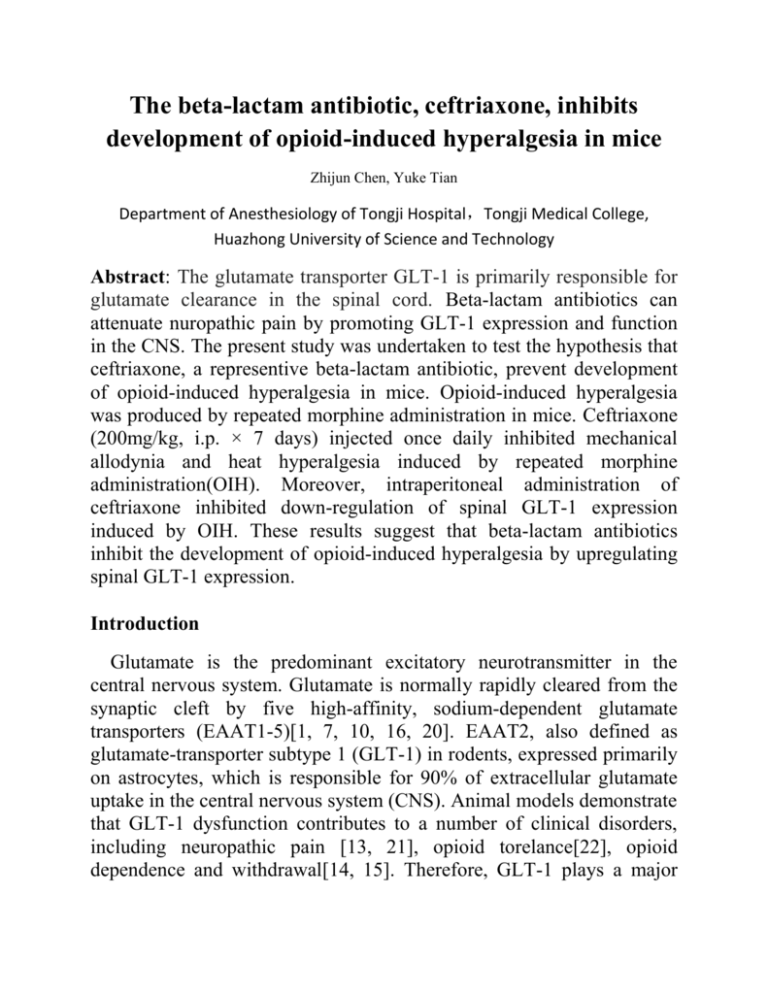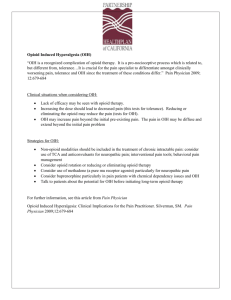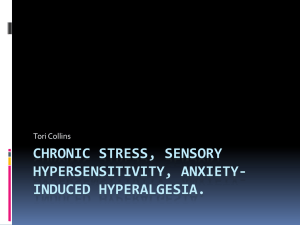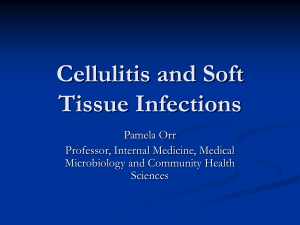The beta-lactam antibiotic, ceftriaxone, inhibits development of
advertisement

The beta-lactam antibiotic, ceftriaxone, inhibits development of opioid-induced hyperalgesia in mice Zhijun Chen, Yuke Tian Department of Anesthesiology of Tongji Hospital,Tongji Medical College, Huazhong University of Science and Technology Abstract: The glutamate transporter GLT-1 is primarily responsible for glutamate clearance in the spinal cord. Beta-lactam antibiotics can attenuate nuropathic pain by promoting GLT-1 expression and function in the CNS. The present study was undertaken to test the hypothesis that ceftriaxone, a representive beta-lactam antibiotic, prevent development of opioid-induced hyperalgesia in mice. Opioid-induced hyperalgesia was produced by repeated morphine administration in mice. Ceftriaxone (200mg/kg, i.p. × 7 days) injected once daily inhibited mechanical allodynia and heat hyperalgesia induced by repeated morphine administration(OIH). Moreover, intraperitoneal administration of ceftriaxone inhibited down-regulation of spinal GLT-1 expression induced by OIH. These results suggest that beta-lactam antibiotics inhibit the development of opioid-induced hyperalgesia by upregulating spinal GLT-1 expression. Introduction Glutamate is the predominant excitatory neurotransmitter in the central nervous system. Glutamate is normally rapidly cleared from the synaptic cleft by five high-affinity, sodium-dependent glutamate transporters (EAAT1-5)[1, 7, 10, 16, 20]. EAAT2, also defined as glutamate-transporter subtype 1 (GLT-1) in rodents, expressed primarily on astrocytes, which is responsible for 90% of extracellular glutamate uptake in the central nervous system (CNS). Animal models demonstrate that GLT-1 dysfunction contributes to a number of clinical disorders, including neuropathic pain [13, 21], opioid torelance[22], opioid dependence and withdrawal[14, 15]. Therefore, GLT-1 plays a major role in terminating synaptic transmission and protecting neurons from glutamate neurotoxicity. Opioids are a class of the most effective analgesics for treating moderate to severe pain. However, chronic morphine not only leads to tolerance and dependence, but also results in nociceptive enhancement called opioid-induced hyperalgesia (OIH)[5]. Although hyperalgesia associated with opioid use has been reported clinically for decades, the underlying mechanism of OIH remains unclear. Therefore clinincal treatment of OIH has been very difficult so far. Rothstein et al. [19] discovered that the beta-lactam class of antibiotics can greatly and selectively promote GLT-1 expression and function in the CNS. And animal studies demonstate that beta-lactam antibiotics can attenuate nuropathic pain[9], morphine torelance[18] and dependence[17]. Therefore this study tested the hypothesis that ceftriaxone, a representive beta-lactam antibiotic, would inhibit development of opioid-induced hyperalgesia in mice. Materials and Methods Animals Experiments were performed on male ICR mice (25±5 g, Harlan Laboratories, Indianapolis, IN). Animals were provided food and water ad libitum with a 10:14 h light:dark cycle. Mice were randomly divided into experimental groups according to a computer generated randomization list. All animal experiments were carried out in accordance with the International Association for the Study of Pain (IASP) and the National Institute of Health Guidelines for the handling and use of laboratory animals after approval by the University of Illinois Institutional Animal Care and Use Committee. Drugs and administration Morphine sulfate was obtained from the National Institute on Drug Abuse (Rockville, MD) and injected subcutaneously. Ceftriaxone was purchased from Sigma (St. Louis, MO) and injected intraperitoneally. To induce OIH, mice were treated subcutaneously according to a previously published schedule [4, 11]. Mice received 20 mg/kg morphine sulfate (twice per day, s.c.) for 3 consecutive days and two more injections of 40 mg/kg morphine sulfate on day 4. Mice from both groups were injected once daily with either ceftriaxone (200 mg/kg) or equal volume of saline, beginning 3 days before the start of morphine injection. Mechanical and thermal sensitivities were tested before and after morphine treatment. Mechanical allodynia Mechanical sensitivity was determined using calibrated von Frey filaments (Stoelting, Wood Dale, IL) as previously described [2, 3, 12, 23]. These tests were performed before ceftriaxone injection to obtain the baseline mechanical sensitivity and daily post-morphine injection by the same researcher. The up-down paradigm was used to determine 50% probability of paw withdrawal threshold [2, 3, 6, 12]. Thermal hyperalgesia The paw withdrawal latencies to radiant heat were tested using a plantar tester (model 7372, UGO BASILE, VA, Italy) as described previously[3, 8, 12, 23]. Mice were placed in a transparent cage on a glass floor. The radiant heat source was focused on the central portion of the plantar surface of the left hindpaw and paw withdrawal latencies were recorded when the heat source was automatically turned off as a result of paw withdrawal. A cut-off time of 20 s was applied in order to prevent tissue damage. Western blotting analysis The lumbar sections of the spinal cord were quickly dissected from euthanized mice and frozen in acetone-dry ice solution and stored -80 °C, or immediately processed for western blotting analysis as previously described [3, 12, 24]. Briefly, tissues were homogenized in RIPA buffer in the presence of phosphatase inhibitors (10mM sodium fluoride, 10mM sodium pyrophosphate, and 1 mM sodium orthovanadate and 1 μM okadaic acid) and protease inhibitors (0.05 mg/ml bestatin, 0.05 mg/ml leupeptin, 0.05 mg/ml pepstatin, and 0.1 mg/ml phenylmethylsulfonylfluoride). The homogenates were incubated on a rotator for 1 h and centrifuged (45,000 × g) for 1 h at 4 °C. Protein content in the supernatant was determined by a modified Bradford method (Pierce Biotechnology, Rockford, IL). Samples were then separated by SDS-PAGE and electrotransferred onto PVDF membrane for western blotting analyses. Antibodies including a rabbit anti-GLT1antibody (1:1000; Cell Signaling Technology, Beverly, MA), and a mouse anti-β-actin antibody (1:10,000, Sigma); and corresponding HRP conjugate secondary antibodies (Amersham, Piscataway, NJ) were used. The enhanced chemiluminescence signals (Pierce Biotechnology) were captured by a ChemiDoc imaging system and analyzed using the Quantity One program (BioRad, Hercules, CA). Ratios of the optical densities of GLT-1 to those of β-actin were calculated for each sample. Statistical analysis A two-way repeated-measures ANOVA was used to determine differences among groups. Student–Newman–Keuls test was used as a post-hoc test. Statistical significance was established at the 95% confidence limit. Results Intraperitoneal administration of ceftriaxone inhibited development of OIH in mice Four days of subcutaneous morphine administration by intermittent injections significantly increased mechanical and thermal sensitivities compared with saline-treated mice(Fig. 1). Intraperitoneal preventive administration of ceftriaxone, given once daily for seven days beginning 3 days before the start of chronic morphine injection, before the development of hyperalgesia, significantly increased the mechanical withdrawal threshold and thermal withdrawal latency, as compared with OIH mice in the corresponding time points observed (Fig. 1A, B). The effect was evident from postinjection day 1 and continued until postinjection day 7 (Fig. 1A, B). However, the intraperitoneal administration of saline in the same protocol had no effect on the decreased mechanical withdrawal threshold and thermal withdrawal latency induced by OIH (Fig. 1A, B). The results suggested that the preventive administration of ceftriaxone could prevent the development of mechanical allodynia and thermal hyperalgesia induced by OIH. Intraperitoneal administration of ceftriaxone inhibited downregulation of spinal GLT-1 expression induced by OIH Western blotting analysis showed that spinal GLT-1 protein expression obviously decreased in the OIH mice (Fig. 2). Repeated intraperitoneal administration of ceftriaxone significantly prevented the downregulation of GLT-1 protein expression induced by OIH on postinjection day 7 (Fig. 2). The preventive effect of ceftriaxone on the downregulation of GLT-1 after OIH was coincident in time course with its preventive effect on hyperalgesia behaviors induced by OIH. Discussion In the present study we testes the hypothesis hat repeated intraperitoneal administration of ceftriaxone can inhibit the development of hyperalgesia. We found that ceftriaxone (200mg/kg, i.p. × 7 days) inhibited opioid-induced mechanical allodynia, heat hyperalgesia and downregulation of spinal GLT-1 expression. As we know, the glutamate transporter plays a major role in the maintenance of glutamate homeostasis. Of the five glutamate transporters, GLT-1 (EAAT2) is responsible for 90% of glutamate uptake in the central nervous system (CNS). Prior studies have shown that the development of hyperalgesia was accompanied by the downregulation of GLT-1 protein and its uptake of glutamate in many pain models such as CCI[21] and spinal nerve transection[25]. In this study we found that the development of opioid-induced hyperalgesia was also associated to the down-regulation of GLT-1 protein in the spinal cord. A recent report published in nature [19] indicated that the beta-lactam class of antibiotics increased GLT-1 expression, functional and biochemical activity in the brain and spinal cord. Because beta-lactam antibiotics are the most widely used antibiotics in the world, which cause no known side effects clinically, they may be useful in the management of GLT-1 disfunction. Hu et al [9] reported that systemic treatment with ceftriaxone prevented and reversed CCI-induced mechanical allodynia and heat hyperalgesia. Prior studies have shown that repeated intraperitoneal treatment with ceftriaxone limits the development of tolerance to repeated morphine injections as well as alleviating naloxone-induced morphine withdrawal and inhibits development of morphine physical dependence[17, 18]. The present data show that intraperitoneal ceftriaxone pre-treatment inhibited opioidinduced mechanical allodynia and heat hyperalgesia. In summary, we found that ceftriaxone inhibited development of OIH by upregulating GLT-1 expression in lumbar spinal cord in mice. Downregulation of spinal GLT-1 is involved in the generation of OIH. These findings highlight the possibility of a new clinical strategy to prevent OIH. A Saline+Saline Saline+MS Cef+MS Paw withdrawal threshold (g) 1.5 1.0 0.5 0.0 *** *** *** *** Cef 0.2g/kg i.p. -2 -1 0 1 2 3 4 5 6 7 8 9 10 11 Days Paw withdrawal latency (s) B Saline+Saline Saline+MS Cef+MS 12 10 8 6 4 Cef 0.2g/kg i.p. *** *** *** *** -2 -1 0 1 2 3 4 5 6 7 8 9 10 11 Days Fig. 1 The effect of intraperitoneal administration of Cef on mechanical/thermal withdrawal latency of OIH mice. The horizontal black bars represent the period of Cef administration. The downward arrows indicate the time point which mice received saline or morphine sulfate (day 1– 3: 20 mg/kg; day 4: 40 mg/kg; twice daily, s.c.). Data are expressed as mean±SEM *p<0.05, **p<0.01, ***p<0.001, compared with the saline-treated group; n=5 for each group. GLT-1 -actin Normalized OD of GLT-1/beta-actin 1.5 # 1.0 * 0.5 0.0 Saline+Saline Saline+MS Cef+MS Fig. 2 OIH-induced down-regulation and Cef-induced up-regulation of GLT-1 expression in lumbar spinal cord. Data are expressed as mean±SEM, *p<0.05, compared with the salinetreated group; #p<0.05, compared with the morphine-treated group; n=4 for each group. Reference [1] [2] [3] [4] [5] [6] [7] [8] [9] [10] [11] [12] [13] [14] [15] [16] [17] [18] J.L. Arriza, S. Eliasof, M.P. Kavanaugh, S.G. Amara, Excitatory amino acid transporter 5, a retinal glutamate transporter coupled to a chloride conductance, Proc Natl Acad Sci U S A 94 (1997) 4155-4160. S.R. Chaplan, F.W. Bach, J.W. Pogrel, J.M. Chung, T.L. Yaksh, Quantitative assessment of tactile allodynia in the rat paw, J Neurosci Methods 53 (1994) 55-63. Y. Chen, F. Luo, C. Yang, C.M. Kirkmire, Z.J. Wang, Acute inhibition of Ca2+/calmodulindependent protein kinase II reverses experimental neuropathic pain in mice, J Pharmacol Exp Ther 330 (2009) 650-659. Y. Chen, C. Yang, Z.J. Wang, Ca2+/calmodulin-dependent protein kinase II alpha is required for the initiation and maintenance of opioid-induced hyperalgesia, J Neurosci 30 38-46. L.F. Chu, M.S. Angst, D. Clark, Opioid-induced hyperalgesia in humans: molecular mechanisms and clinical considerations, Clin J Pain 24 (2008) 479-496. W.J. Dixon, Efficient analysis of experimental observations, Annu Rev Pharmacol Toxicol 20 (1980) 441-462. W.A. Fairman, R.J. Vandenberg, J.L. Arriza, M.P. Kavanaugh, S.G. Amara, An excitatory aminoacid transporter with properties of a ligand-gated chloride channel, Nature 375 (1995) 599-603. K. Hargreaves, R. Dubner, F. Brown, C. Flores, J. Joris, A new and sensitive method for measuring thermal nociception in cutaneous hyperalgesia, Pain 32 (1988) 77-88. Y. Hu, W. Li, L. Lu, J. Cai, X. Xian, M. Zhang, Q. Li, L. Li, An anti-nociceptive role for ceftriaxone in chronic neuropathic pain in rats, Pain 148 284-301. Y. Kanai, M.A. Hediger, Primary structure and functional characterization of a high-affinity glutamate transporter, Nature 360 (1992) 467-471. D.Y. Liang, G. Liao, J. Wang, J. Usuka, Y. Guo, G. Peltz, J.D. Clark, A genetic analysis of opioidinduced hyperalgesia in mice, Anesthesiology 104 (2006) 1054-1062. F. Luo, C. Yang, Y. Chen, P. Shukla, L. Tang, L.X. Wang, Z.J. Wang, Reversal of chronic inflammatory pain by acute inhibition of Ca2+/calmodulin-dependent protein kinase II, J Pharmacol Exp Ther 325 (2008) 267-275. S. Maeda, A. Kawamoto, Y. Yatani, H. Shirakawa, T. Nakagawa, S. Kaneko, Gene transfer of GLT-1, a glial glutamate transporter, into the spinal cord by recombinant adenovirus attenuates inflammatory and neuropathic pain in rats, Mol Pain 4 (2008) 65. T. Ozawa, T. Nakagawa, Y. Sekiya, M. Minami, M. Satoh, Effect of gene transfer of GLT-1, a glutamate transporter, into the locus coeruleus by recombinant adenoviruses on morphine physical dependence in rats, Eur J Neurosci 19 (2004) 221-226. T. Ozawa, T. Nakagawa, K. Shige, M. Minami, M. Satoh, Changes in the expression of glial glutamate transporters in the rat brain accompanied with morphine dependence and naloxoneprecipitated withdrawal, Brain Res 905 (2001) 254-258. G. Pines, N.C. Danbolt, M. Bjoras, Y. Zhang, A. Bendahan, L. Eide, H. Koepsell, J. Storm-Mathisen, E. Seeberg, B.I. Kanner, Cloning and expression of a rat brain L-glutamate transporter, Nature 360 (1992) 464-467. S.M. Rawls, D.A. Baron, J. Kim, beta-Lactam antibiotic inhibits development of morphine physical dependence in rats, Behav Pharmacol 21 161-164. S.M. Rawls, M. Zielinski, H. Patel, S. Sacavage, D.A. Baron, D. Patel, Beta-lactam antibiotic reduces morphine analgesic tolerance in rats through GLT-1 transporter activation, Drug Alcohol Depend 107 261-263. [19] [20] [21] [22] [23] [24] [25] J.D. Rothstein, S. Patel, M.R. Regan, C. Haenggeli, Y.H. Huang, D.E. Bergles, L. Jin, M. Dykes Hoberg, S. Vidensky, D.S. Chung, S.V. Toan, L.I. Bruijn, Z.Z. Su, P. Gupta, P.B. Fisher, Beta-lactam antibiotics offer neuroprotection by increasing glutamate transporter expression, Nature 433 (2005) 73-77. T. Storck, S. Schulte, K. Hofmann, W. Stoffel, Structure, expression, and functional analysis of a Na(+)-dependent glutamate/aspartate transporter from rat brain, Proc Natl Acad Sci U S A 89 (1992) 10955-10959. B. Sung, G. Lim, J. Mao, Altered expression and uptake activity of spinal glutamate transporters after nerve injury contribute to the pathogenesis of neuropathic pain in rats, J Neurosci 23 (2003) 2899-2910. Y.H. Tai, Y.H. Wang, J.J. Wang, P.L. Tao, C.S. Tung, C.S. Wong, Amitriptyline suppresses neuroinflammation and up-regulates glutamate transporters in morphine-tolerant rats, Pain 124 (2006) 77-86. L. Tang, Y. Chen, Z. Chen, P.M. Blumberg, A.P. Kozikowski, Z.J. Wang, Antinociceptive pharmacology of N-(4-chlorobenzyl)-N'-(4-hydroxy-3-iodo-5-methoxybenzyl) thiourea, a highaffinity competitive antagonist of the transient receptor potential vanilloid 1 receptor, J Pharmacol Exp Ther 321 (2007) 791-798. L. Tang, P.K. Shukla, L.X. Wang, Z.J. Wang, Reversal of morphine antinociceptive tolerance and dependence by the acute supraspinal inhibition of Ca(2+)/calmodulin-dependent protein kinase II, J Pharmacol Exp Ther 317 (2006) 901-909. V.L. Tawfik, M.R. Regan, C. Haenggeli, M.L. Lacroix-Fralish, N. Nutile-McMenemy, N. Perez, J.D. Rothstein, J.A. DeLeo, Propentofylline-induced astrocyte modulation leads to alterations in glial glutamate promoter activation following spinal nerve transection, Neuroscience 152 (2008) 1086-1092.





